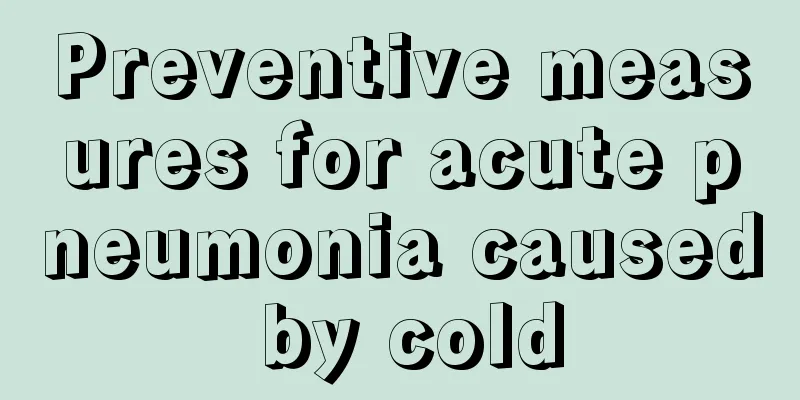Preventive measures for acute pneumonia caused by cold

|
Almost everyone will catch a cold, and severe colds often cause acute pneumonia. If patients with acute pneumonia are not treated in time, it is easy to lead to death. Therefore, patients with acute pneumonia caused by colds must do a good job of prevention. So, what are the preventive measures for acute pneumonia caused by colds? Let’s take a brief look at it! General care and supportive therapy The room temperature should be maintained at around 20°C and the relative humidity should be 55-65% to prevent respiratory secretions from drying out and becoming difficult to cough up. In winter, you should open windows regularly for ventilation, 30 minutes each time, 3 times a day, avoid convection wind, pay attention to rest, implement strict respiratory isolation system, and prevent cross infection. Closely observe changes in the condition and provide appropriate treatment in a timely manner. For children with a bluish-gray complexion, cyanosis around the mouth, irritability or drowsiness, attention should be paid to changes in heart sounds and heart rate, and observation should be made for the occurrence of myocarditis. If the cyanosis worsens after feeding or crying, and is not relieved after oxygen inhalation, the cause should be identified and treated in a timely manner. Pay attention to nutrition and water supply; breastfeeding should be done as much as possible. If bottle-feeding is required, the amount and concentration of milk can be determined according to the baby's digestive function and condition. If the baby has diarrhea, skimmed milk should be given. For infants or children, a light, easily digestible diet rich in multiple vitamins should be provided. Children in the recovery period should be given nutritious, high-calorie food. For critically ill children who cannot eat, intravenous infusion should be given to supplement calories and water. The daily fluid volume should be 60-80ml/kg. Whole blood or plasma can be transfused if necessary. People who also suffer from rickets should be treated with vitamin D3 injections. To keep the airway open, nasal crusts, nasal secretions and respiratory sputum should be removed promptly. Improve ventilation function, increase alveolar ventilation, correct hypoxia, and reduce CO2 retention. For those with a lot of thin phlegm, you can turn over and pat your back repeatedly to help the phlegm be discharged. You can also take the expectorant ammonium chloride mixture orally: 1 ml/year, 3 times a day. For those with thick sputum that is difficult to cough up, suction or ultrasonic atomization can be used for inhalation. The liquid formula is 30 ml of normal saline or distilled water, 20,000 U of gentamicin, 5 mg of a-chymotrypsin, and 1 mg of dexamethasone. Each inhalation is for 10-15 minutes, 2-3 times a day. The above are some preventive measures for acute pneumonia caused by colds. These preventive measures are very effective, especially for children who are most prone to acute pneumonia. Parents must understand the treatment measures for acute pneumonia so that children can receive timely treatment when they develop acute pneumonia. |
<<: Is pneumonia with fever serious?
>>: What should I do if my butt hurts after falling
Recommend
Several more serious symptoms of colorectal cancer
It is understood that many patients with colorect...
What are the key points in the treatment of liver cancer? What are the treatment methods of liver cancer that you should know?
There are many treatments for liver cancer, and e...
What are the symptoms of candidal infection?
Candida infection is very common in today's l...
Brief introduction about teratoma
Teratomas originate from potentially multifunctio...
Dull pain in lower abdomen after moxibustion
The pain in the lower abdomen after moxibustion i...
How does an air purifier work?
Now we have to say that the air quality outside i...
How many hours of deep sleep is good every day
Modern scientific research shows that people cann...
How much do you know about egg-laying mammals?
Animals are human’s best friends and are deeply l...
What medicine is good for treating cheilitis
There are many ways to treat cheilitis, usually w...
Is it good to play badminton if you have cervical spondylosis
Playing badminton can be said to be a sport that ...
Can I eat a lot of watermelon after an abortion?
In today's society, abortion is both normal a...
What's wrong with coughing and being afraid of cold?
Coughing is a stress response of the respiratory ...
How to arrange reasonable medication for teratoma in daily life
Teratomas are best treated surgically. Teratomas ...
International Histological Classification of Gastric Cancer
The gross morphology of advanced gastric cancer v...
What should I do if I haven't gotten pregnant after taking folic acid for three months?
Many female friends actually have a very hard tim...









